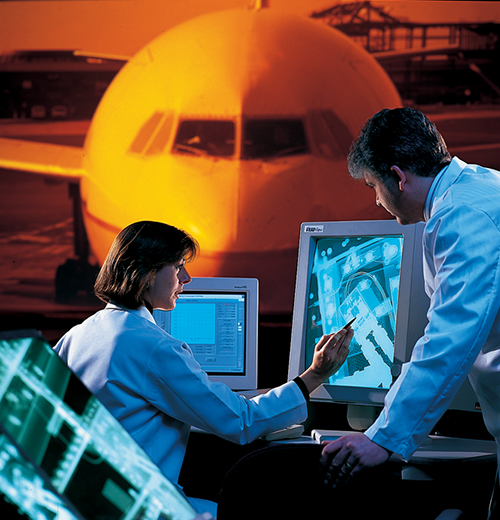Filmless Radiography
Liberty Technologies, Inc. of Conshohocken, Pennsylvania, has seen the future of industrial radiography and it is filmless. Thanks to the company's RADView™ technology, licensed from Quantex Corporation of Rockville, Mary land, that future vision is now.
Radiography is implemented in a number of aerospace, oil and gas, and utility applications. It is particularly useful for visualization of cracks, erosion and corrosion problems, and checking the nature of welds, assuring integrity by direct imaging of internal structure. Defects can be discerned in a noninvasive manner. Costly and sometimes deadly catastrophic failures can be prevented through radiography.
RADView is a new filmless technology, a total imaging solution for the conversion of radiographic film records to digital format and digital acquisition of radiographs.
R. Nim Evatt, president and CEO of Liberty Technologies considers the RADView as the first practical advance in technology for industrial radiographic imaging since the discovery of x-rays over 100 years ago.
The system works much the same way as a common medical x-ray--the object to be imaged is first exposed to radiation. But using RADView, a thin and flexible Storage Phosphor Screen--in place of conventional film--records and stores the image. This phosphor screen is a solid-state media. A stored image can be read with a laser and directly digitized for electronic viewing. After viewing or archiving is complete, the screen can be erased, ready for the next image.
Initially prototyped under a Small Business Innovation Research (SBIR) contract between Quantex Corporation and Langley Research Center, the solid-state radiography system can capture latent images with wider dynamic range at lower x-ray or gamma doses than conventional film systems. NASA-sponsored work by Quantex involved the investigation of a technology called Electron Trapping (ET®). That research led to a solid-state film that uses a special class of photoluminescent materials to capture radiographic images.
In June 1994, Quantex signed a license agreement with Liberty Technologies, which further developed and now markets filmless radiography systems for inspection of industrial components. The core work of Liberty is to provide diagnostic, condition monitoring and nondestructive evaluation programs, products and services to manage critical assets and processes in industries worldwide.
RADView converts existing radiographic film to a digital format and digitally acquires images employing the patented phosphor technology. A trio of benefits is immediately realized by the RADView technology: reduction of exposure times and errors; film waste and expense is eliminated; and the efficiency of data management and precise image analysis is boosted.
Liberty's commercial systems rapidly acquire and digitize radiographic images of objects, which then can be viewed and enhanced electronically. The system's software enables a much greater range of information to be gleaned.
Yet another advantage of the RADView approach is that, in general, the solid-state film can be exposed, read, erased, and re-exposed indefinitely until mechanical wear replacement is required. Furthermore, the solid-state film allows electronic archiving and transmission of images. Typically, radiographic films begin to degrade after roughly 10 years. Liberty's digital images, however, can be stored to optical media for up to 100 years and beyond without information loss as well as at low cost.
Liberty has already begun to introduce the RADView to selected overseas markets that require industrial radiography as it is a billion dollar market worldwide.
RADView is a trademark of Liberty Technologies, Inc.
ET is a registered trademark of Quantex Corporation.

RADView provides efficient digital radiography of industrial components to catch wear, erosion, or other defects. The initial research was sponsored by NASA through a Small Business Innovation Research contract.













